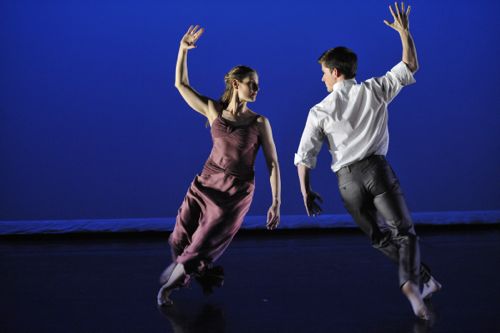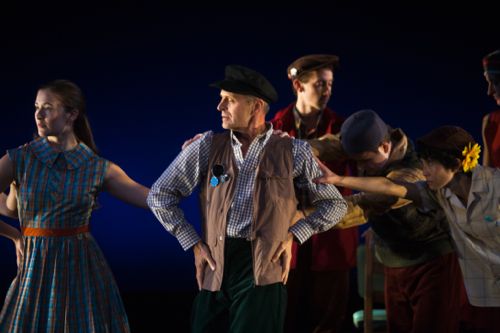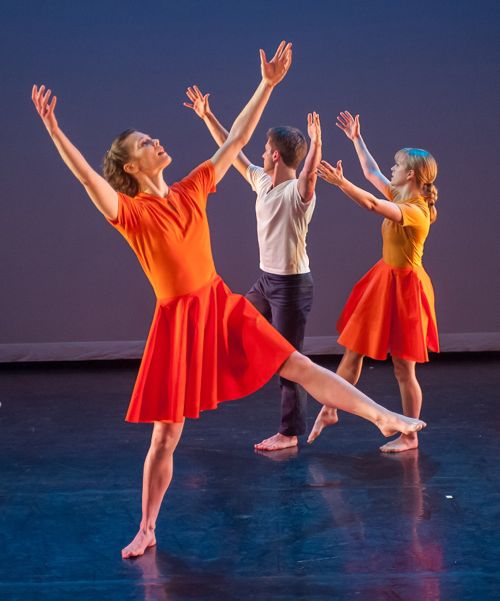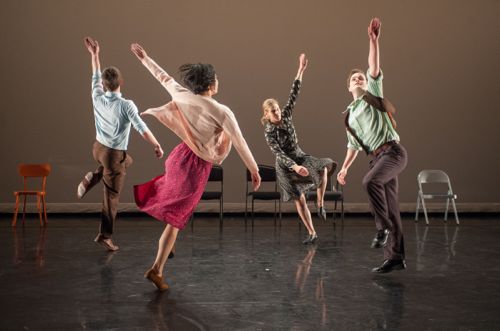Mark Morris Dance Group / James and Martha Duffy Performance Space, Mark Morris Dance Center, Brooklyn, NY / April 3-14, 2013
Jenn and Spencer, being given its world premiere on the opening night of the Mark Morris Dance Group’s run at the company’s studio/theater in Brooklyn, refers to two of the company’s splendid dancers, Jenn Weddel and Spencer Ramirez. The duet named for and performed by them illustrates the magic a pair of dancers may be capable of and an extraordinary exploration of the duet form.
 Mark Morris Dance Group’s Jenn Weddel and Spencer Ramirez in Morris’s new Jenn and Spencer
Mark Morris Dance Group’s Jenn Weddel and Spencer Ramirez in Morris’s new Jenn and Spencer
Photo: Stephanie Berger
If you’re seduced by clothes, of course (and I am), the first thing you notice is Weddel’s ravishing floor-length gown, executed in faintly glistening burnt sienna. Ramirez’s costume rightly makes no attempt to compete but complements it simply with a pale shirt and slate gray semi-gloss trousers. (The costumes were designed by Stephanie Sleeper.) Almost immediately, however, your attention is directed to Morris’s ingenious choreography.
The two dancers seem driven to couple yet appear resistant to the project, as if it might ruin their plans for their singular selves. So initially they behave like inevitable antagonists, Jenn, for example, devoting herself to a long, busy solo. Spencer responds by creeping under the skirt of her handsome gown and manipulating her body. Still, her attitude consistently remains independent, in no way cooperative and certainly not submissive.
Next she turns her back on him, as if prepared to stride away, but he’s not willing to give up—and perhaps he knows her innermost desire too. He does a busy rapid solo while she looks on. And then he disappears. She goes on dancing; he reappears as if to reconcile; and then, arm in arm, they survey their perhaps limited terrain of togetherness. Suddenly she does a backwards fall, straight down, and he supports her at the very last moment. Their duet concludes with their starting anew with an angry section that escalates to an abrupt end because that’s all there is to say. I found the piece true, moving, and admirably devoid of sentiment.
 Mikhail Baryshnikov (center, in a checked shirt), with members of the MMDG, in Morris’s The Wooden Tree
Mikhail Baryshnikov (center, in a checked shirt), with members of the MMDG, in Morris’s The Wooden Tree
Photo: Tim Summers
Mikhail Baryshnikov, who has been buddies in the dance field with Mark Morris for ages—both dazzling in their respective talents, accomplishments, and gift for collaboration—appeared with the Mark Morris Dance Group to star in Morris’s newish A Wooden Tree. With music and words by Ivor Cutler—“I Love You But I Don’t Know What I Mean,” “I Got No Common Sense,” for instance—the piece could be thought of as a failed instruction manual on love emanating from a Scottish venue that has not yet conferred much sophistication on its populace. It poses familiar, unresolved questions like “Why don’t a woman love a woman?” (And the same for other gender pairings.) All-purpose answer: “Because it’s trouble all the time.” It turns out that hetero coupling has the very same unfortunate result.
In explicating this problem Baryshnikov makes phrases of Morris-style pantomime sharper than ever—amazing clarity has always been part of his dancing—and jives around the space as if he had a whisky bottle in his pocket and nary a care in the world except, alas, for ever-recurring problems of the heart. This fellow, unfortunately typical of the human race, and he and his (let’s call her his lover until she’s not any more) sit and stare at each other as the piece goes on: “What do we talk of when we meet? Nothing at all. We have a beautiful cosmos.” “Cosmos” is twisted with irony.
 Laurel Lynch (foreground) with her MMDG colleagues in Morris’s new Crosswalk
Laurel Lynch (foreground) with her MMDG colleagues in Morris’s new Crosswalk
Photo: Stephanie Berger
The world premiere of Crosswalk was given a suitably lively performance on opening night, with Todd Palmer on clarinet and Colin Fowler on piano playing Carl Maria von Weber’s Grand Duo Concertant. It reminded me of unabashedly upbeat works that the New York City Ballet often used as definitive “send ‘em home happy” pieces.
True to its title, Crosswalk contains lots of parading—in simple formations, most often on a horizontal path, which is, after all, how a spectator sees a parade. My favorite bits involved what I thought were references to Balanchine’s Apollo–for instance, the moment, in which a man “drives“ a trio of women as if they were an lively matched brace of fillies. Clarity of vision pervades the piece and that alone is a plus. But do I yearn to see it again? Yes, because one’s first look at a Morris work—like one of Alexei Ratmansky’s or, indeed, Balanchine’s—never yields everything there is to see and think about. No, because Morris has repeatedly shown himself capable of far more subtlety and innovation. Elizabeth Kurtzman’s costumes for the women in variations on a theme of orange should have been stopped when the first bolt of fabric appeared in the workroom.
 MMDG dancers in Morris’s The Office
MMDG dancers in Morris’s The Office
Photo: Stephanie Berger
Included in the program was The Office (from 1994) in which Dvořák’s Bagatelles for two violins, cello, and harmonium accompanies a story that is banal on the surface but, Morris being Morris, ominous in its implications. A handful of young job-seekers are summoned, one by one, by–a minor company official, I guess she is—presumably to an interview that will decide their immediate nine-to-five fate. The tone hints—just hints, mind you—that the summons may result in a fate even worse than a file clerk’s dreary servitude. Morris tends to be timely only obliquely or with a universal application that leaves the actual specifics of his concern vague, but the very subject of The Office is nevertheless perfect in the light of today’s unemployment woes.
The original costumes for the piece were curated by June Omura, a long-time dancer with Morris, from clothes she found in thrift shops. Pina Bausch started out dressing her dancers in this way too and, to my mind (partially educated by this infinitely evocative second-hand source) the switch to blatantly gorgeous, expensive costumes lessened the richness of her work.
© 2013 Tobi Tobias




When first danced, The Office seemed to a lot of people an oblique reference to the Balkan Wars. Summons to an execution, dancer by dancer. Omura’s costumes even looked like drab Bosnian hand-me-downs. This was a powerful, chilling piece–way beyond unemployment lines.
Thank you for writing, Harriet. As I said in my piece, Morris’s dances are often subject to myriad interpretations. This is part of their allure.
Thanks, Tobi, for your invaluable commentary over so many years. Please keep writing.
Hello, Tobi,
Just waking in Seattle and read your review of Mark Morris…delightedly. He came here to a small venue and we had a rare opportunity to see and feel the work up close. The experience was one of the long awaited for evenings of dance. My appreciation for his company and the unity of the dancers was cemented with that evening.
Thank you for writing so clearly and capturing the values of his work and dancers.
Warm Regards,
Stephanie
Thanks!
You put your finger on something really fundamental about Morris with your comments on his mime work — he does indeed value that kind of story-telling much more highly than is popular currently. After seeing his Hard Nut, I’ve wondered what he might do with a Bournonville work, where mime is so tightly integrated and organically developed.
I was lucky enough to see one of Baryshnikov’s appearances with the company in Seattle last autumn, and was struck by how much pleasure he seemed to take from dancing as a part of the group. Some of Morris’s truly affecting works deal with groups — belonging to a particular tribe. You can read The Office in many different ways, but I think the idea of belonging is always there.